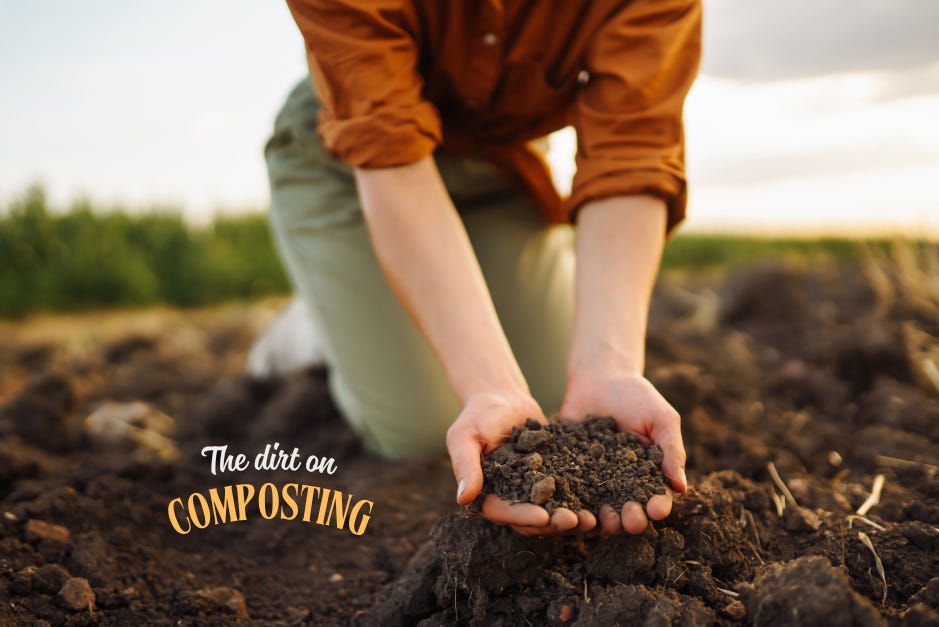The Dirt on Composting
I'm digging in to the benefits of composting. Here's everything you need to know to get started.
May 29 is Learn About Composting Day, so today’s post is all about the nitty gritty goodness of composting. This article is full of info, so let’s dig in!
Why composting is good for the planet
Composting reduces waste
In Canada, an estimated 40% of municipal solid waste is composed of organic materials. Of that, 28% is food waste. In 2016, just under 6 million tonnes of food waste were sent to landfill. While we need to create less food waste to begin with, composting is a great way to divert food scraps from the landfill and turn them into nutrient-rich soil.
Composting reduces greenhouse gas emissions
By diverting organic waste from landfills, composting helps reduce greenhouse gas emissions. When organic matter gets buried under trash in a landfill, it’s deprived of the oxygen needed by beneficial microorganisms to break it down. The waste then undergoes anaerobic decomposition, being broken down by organisms that can live without oxygen. Anaerobic decomposition creates biogas, which is 45% to 65% methane, and the rest carbon dioxide — both potent greenhouse gases.
Compost improves soil health
Compost contains the essential nutrients and elements needed by plants, reducing the need for chemical fertilizers. But compost is more than just plant food: it’s alive with beneficial microbes that help with nutrient cycling, disease suppression, and plant growth. Compost also improves soil structure, enhancing water retention and aeration.
Why you should compost at home, even if your municipality handles compost
Even if your municipality collects and processes compost, there are still many reasons to compost at home:
FREE compost
Why buy compost or fertilizer when you can make it for free? Home composting provides you with tons of nutrient-rich compost to use in your garden.
Reducing GHG emissions
By composting at home, you reduce the energy and emissions associated with hauling organic waste to municipal facilities.
More control
Home composting lets you to decide what goes into your compost pile, ensuring it is free of contaminants.
Types of composters
Stationary composters: With a stationary composter, you to add waste at the top and harvest mature compost through a door at the bottom. While stationary composters require little effort, they can take months to process compost due to limited aeration. These bins are best placed on soil for optimal results.
Compost tumblers: Also called rolling or tumbling composters, compost tumblers feature a rotating drum that helps aerate and mix materials for quicker composting. Some models have dual chambers, allowing you to process one batch while adding new scraps to the other. I use this dual chamber tumbling composter.
Worm composters: Also called vermiculture composters or “wormeries” (so cute), worm composters use specific worm species — usually red wigglers (Eisenia fetida) and redworms (Lumbricus rubellus) to convert food waste into compost. Worms speed up the decomposition process, and as they become established, they become even more efficient.
Worm composters like this Essential Living Composter are often tiered to ensure you always have somewhere to add material. You can even get a super stylish wormery for using indoors.
Food waste digesters: Food waste digesters process organic waste like dairy, meat, bones, pet waste, and any organic matter that can’t go in your regular composter. They work by using a buried lower basket and a sun-heated cone. Microorganisms handle most of the waste, converting it to liquid that seeps into the ground. These will help you reduce the food waste that goes to landfill, but they don’t produce compost you can use for your garden.
Countertop composters: Countertop composters like the Lomi and the Foodcycler use a combination of heating, grinding, and moisture control to accelerate decomposition. They essentially mimic the natural composting process on a smaller scale. These are handy for apartments, condos, or even offices — where municipal composting isn’t always available. You can add the compost to potted plants or balcony gardens — or save it for the spring and bring it to a community garden.
Composting Dos and Don’ts
Do:
Add kitchen scraps like fruit peels, vegetable ends, coffee grounds, and eggshells.
Include yard waste like grass clippings, leaves, and small branches.
Use smaller pieces of organic matter to decompose more quickly.
Monitor the temperature to ensure efficient breakdown of materials.
Maintain a proper balance of green (nitrogen-rich) and brown (carbon-rich) materials, such as vegetable scraps and dried leaves, respectively.
Keep your compost moist but not soggy; aim for a consistency similar to a wrung-out sponge.
Don’t:
Add meat, dairy, or oily foods as they attract pests and slow decomposition.
Include diseased plants or invasive weeds.
Add coated paper products or synthetic materials.
I hope these composting tips and insights will inspire you to turn your food and garden waste into your own black gold. Happy composting!
Yours for the Greener Good,
Brett




Rick has a few wormeries in our veggie gardens. Started them a few years ago.